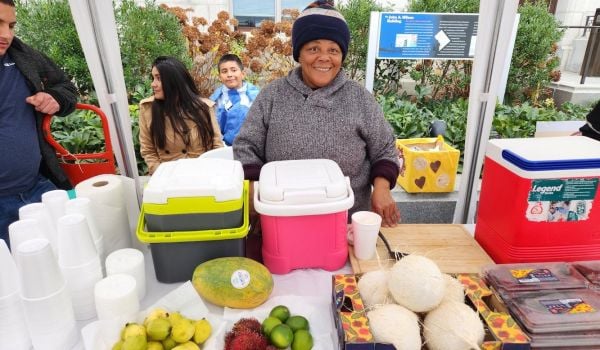This piece originally ran here in June 2011.
Organized “playtime” is growing in popularity in cities across the country as families, schools, and community organizations realize that video and computer games are not modern substitutes for old-fashioned play, but distractions from the true benefits of running outside, socializing with others, and using your imagination. Earlier this year, the New York Times ran a piece entitled “Effort to Restore Children’s Play Gains Momentum,” which explained the value of play to a child’s development. Simply trading in the average 7 hours and 38 minutes in front of a screen for some traditional play helps children with problem solving, exercise, and social skills, such as negotiating. A prominent feature of the article is the Ultimate Block Party, an event in which organizers transformed Central Park into one large playtime with games and toys for 50,000 people (only 10,000 were expected). Like many trends, however, this one has the potential to leave those in most need behind.
With the exception of a paragraph on KaBOOM, a nonprofit organization that builds playgrounds across the country to address the “play deficit” in low-income communities, the article reveals that most efforts to promote play focus primarily on children in middle-income homes. The article conjures up images of parents distracted by blackberrys, who give their children equally mesmerizing handheld devices, who then learn to consult their “playbooks” on how to build a fort (a bed sheet is the material of choice). Given the benefits of play, perhaps these are lessons worth teaching, but what do you do when the barrier isn’t simply a blackberry? What do you do when your entire life creates barriers that prevent your child from simply being a child?
Like many cities across the country, thousands of children in Washington, DC are living in poverty, and many are growing up in homeless shelters. With bare hallways as their playgrounds, these children often do not have the opportunity to play games that would help in their development and provide a release from their circumstances. The Homeless Children’s Playtime Project (HCCP), a nonprofit devoted to bringing the benefits of play to children in shelters around the city, is working to change this.
In 2003, Jamila Larson, a social worker and child advocate, was inspired to create an organization dedicated to serving the District’s homeless children after discovering that the city’s largest homeless shelter kept all donated toys locked in a closet to prevent the children from making a mess. “That’s when I realized that I need to do a whole lot more than donate toys. That we really did need to donate ourselves to make sure those toys could be used,” she said. Today, HCPP serves the vast majority of children in homeless shelters in Washington, DC by creating a child friendly space for children and volunteers to play. Not only does this allow the children to have fun, but it also enables parents to have a couple hours to take a class, get support, or simply have a moment to themselves.
Research has demonstrated that acutely stressful childhood experiences – food insecurity, incarceration of a family member, domestic violence – directly impact the brain, or as Larson put it, creates “brain damage from poverty.” A blank”>2009 study out of Cornell University found that chronic exposure to such stressors during childhood can physiologically impact children’s brains, impairing their working memory and diminishing their ability to develop language, reading, and problem-solving skills. HCPP orientation, volunteers are exposed to these findings, and taught how to make playtime an even more valuable, stress relieving experience for the children while still maintaining a fun and lighthearted atmosphere.
The Park Road shelter, where I volunteer, is in the heart of DC’s Columbia Heights neighborhood. Once a week, I make my way down to the playroom hidden in the shelter’s basement to crawl around for a couple hours, playing games, drawing, and reading to kids from two to nine years old. After one playtime, I spoke with the two volunteer site coordinators, Haley Adams and Stefanie Sprow, to learn more about their experience with the program over the years.
When I asked them about the most rewarding aspect of their work, they immediately began telling a story together. During one playtime, a father came to pick up his son early (we’ll call the boy James) and informed the two of them that it was his sixth birthday. They immediately began scrambling to find a gift in the toy box, and produced a coloring book and some crayons tied with a rubber band. All the volunteers stood before James when he received his gifts. With tears streaming down his face, James went down the line and shook each volunteer’s hand. His father told them “this is probably the only gift he’s going to get for his birthday.”
Many children at the shelter are subject to a variety of experiences that force them to curtail their childhoods. Except during playtime. The two women recalled how angry one child was at playtime when he first began participating in the program – he came from a household that experienced domestic violence. After about a month at playtime, he was noticeably different, even participating in yoga. “A lot of these kids have been traumatized emotionally – all sorts of ways. Through play, a lot of times you can get them to express themselves,” said Adams.
A key ingredient to the program’s success is finding dedicated volunteers like Adams and Sprow. “Some of these kids have gone through changing schools, changing doctors, changing neighborhoods – their entire life has been really inconsistent and we need to start building that consistency within our program,” said Sprow.
Not far from the DC area, the next Ultimate Block Party will take place this fall in Baltimore’s inner harbor waterfront, in order to ensure that the event is “easily accessible to a wide range of families,” according to the event website. It is reassuring that parents are taking time to play with their kids, and that there is an understanding that playtime should be for everyone. Hopefully homeless families will be included in this range as organizers work out the logistics and continue promoting the event. From my own experience, playtime is most rewarding when there’s one big activity that all the kids can participate in because every kid just wants to be asked to play.

Tracey Ross, Associate Director of the All-In Cities Initiative at PolicyLink, works with cities across the country to adopt policies and practices to promote racial inclusion and equitable growth. Prior to joining PolicyLink, Tracey worked at the Center for American Progress focused on urban poverty and environmental justice, and at Living Cities on place-based efforts. In 2012, she was selected as a “Next Vanguard,” Next City’s recognition of 40 urban leaders under 40. Her writing has appeared in The New York Times, ESSENCE, The Washington Post, The Root, The Nation, EBONY.com, and ThinkProgress.


_600_350_80_s_c1.jpg)













